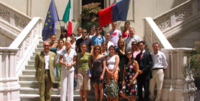Peaceful Europe
|
‘Peaceful Europe’ seeks to promote the systematic integration of peace and non-violence education into various aspects of community life through open-air activities, such as music and sport. It has developed and tested out various formal and informal educational methodologies targeted at young people, adults and senior citizens. The project was undertaken in the context of the ‘learning and teaching cities’ concept.
Objective
The project aims to mainstream peace and non-violence into every aspect of the formal and informal education process in the areas it covers. For instance, peace education could be woven into a diverse range of curricula from history to environmental studies.
Background
The Treaties establishing the European Economic Community (EEC) and the European Atomic Energy Community (EAEC, otherwise known as 'Euratom'), or the Treaties of Rome, signed on 25 March 1957 (and came into force on 1 January 1958), led to the foundation of the European Economic Community after the 2nd world war, marked the strong commitment of western Europe to create an environment that would make any war impossible.
The gradual evolvement of the European Union reflects Europe’s decision to guarantee peace, freedom, security, and democracy within its geographical boundaries. The enlargement that took place in 2004 and 2007 manifested Europe’s commitment to build an environment of stability, where all its citizens can enjoy economic prosperity and peace. With its recently formulated “Neighborhood Policy,” the European Union embraced in this zone of peace and security also countries in its Eastern and Southern borders.
On the 60th anniversary of the liberation from fascism, the European Commission launched the European Union Democracy Campaign. The campaign aims to raise awareness on European values, such as peace, freedom security, and democracy. The objective is to establish pluralism, non-discrimination, tolerance, justice, solidarity, and equality as the building blocks of European identity and of the European integration process.
The Peaceful Europe project is joint venture between Cyprus, Italy, and Slovakia. The purpose of the project is to design, develop, and implement tools and activities, which cultivate peace and non-violence. Various music, theater, sport, and dancing activities are planned within the framework of the “International Decade for a culture of peace and non-violence for the children of the world 2001-2010,” declared by the UN.
Results
Peaceful Europe’ is contributing to the goal of promoting intercultural understanding and dialogue through peace education.Peace and non-violence education can also help European citizens understand the root causes of conflict and war in other parts of the world and consider innovative ways of resolving such crises. By educating today’s children on the subject of peace and non-violence we invest in a conflict-free tomorrow.
People
The Handout
File: PeacefulEuropeHandOut_TL_27July07.pdf
The Survey
File: 20070128_PeaceEU_Survey_TrGR.pdf
The Workshop
File: PeacefulEurope_Cultural_Teens_detailedworkshop_plan_KW_APR.pdf
